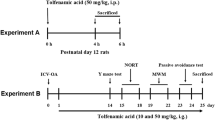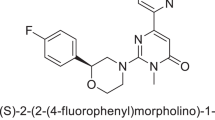Abstract
To investigate the effect of escitalopram (a widely used and highly efficacious antidepressant from the SSRI class) on tau hyperphosphorylation, HEK293/tau441 cells were pretreated with 4 μM of forskolin for 2 h. Then we treated the cells with different doses of escitalopram (0, 5, 10, 20, 40, 80 μM) for 22 h. We measured the phosphorylation level of tau by Western blotting. It was shown that escitalopram could protect tau from hyperphosphorylation induced by pharmacological activation of protein kinase A (PKA) at a dose of 20, 40, and 80 μM in vitro. Interestingly, the same dose of escitalopram could also increase the level of serine-9-phosphorylated GSK-3β (inactive form) and the phosphorylation level of Akt at Ser473 (active form) with no significant change in the level of total GSK-3β and Akt. Unexpectedly, 5-hydroxytryptamine 1A receptor (5-HT1A) agonist 8-OH-DPAT did not decrease forskolin-induced tau hyperphosphorylation. Our results suggest that escitalopram can ameliorate forskolin-induced tau hyperphosphorylation, which is not through the typical 5-HT1A pathway, and Akt/GSK-3β signaling pathway is involved. These findings may support an effective role of antidepressants in the prevention of dementia associated with depression in patients.




Similar content being viewed by others
References
Avila J (2006) Tau phosphorylation and aggregation in Alzheimer’s disease pathology. FEBS Lett 580:2922–2927
Barreto RA, Walker FR, Dunkley PR, Day TA, Smith DW (2012) Fluoxetine prevents development of an early stress-related molecular signature in the rat infralimbic medial prefrontal cortex. Implications for depression. BMC Neurosci 13:125
Beaulieu JM, Zhang X, Rodriguiz RM, Sotnikova TD, Cools MJ, Wetsel WC, Gainetdinov RR, Caron MG (2008) Role of GSK3 beta in behavioral abnormalities induced by serotonin deficiency. Proc Natl Acad Sci U S A 105:1333–1338
Birnbaumer L (2007) Expansion of signal transduction by G proteins. The second 15 years or so: from 3 to 16 alpha subunits plus betagamma dimers. Biochim Biophys Acta 1768:772–793
Blakely RD, De Felice LJ, Hartzell HC (1994) Molecular physiology of norepinephrine and serotonin transporters. J Exp Biol 196:263–281
Briones A, Gagno S, Martisova E, Dobarro M, Aisa B, Solas M, Tordera R, Ramirez M (2012) Stress-induced anhedonia is associated with an increase in Alzheimer’s disease-related markers. Br J Pharmacol 165:897–907
Chen CP, Eastwood SL, Hope T, McDonald B, Francis PT, Esiri MM (2000) Immunocytochemical study of the dorsal and median raphe nuclei in patients with Alzheimer’s disease prospectively assessed for behavioural changes. Neuropathol Appl Neurobiol 26:347–355
Chen F, Larsen MB, Neubauer HA, Sanchez C, Plenge P, Wiborg O (2005) Characterization of an allosteric citalopram-binding site at the serotonin transporter. J Neurochem 92:21–28
Cooper DM, Londos C (1982) GTP-dependent stimulation and inhibition of adenylate cyclase. Horiz Biochem Biophys 6:309–333
Couto FS, Batalha VL, Valadas JS, Data-Franca J, Ribeiro JA, Lopes LV (2012) Escitalopram improves memory deficits induced by maternal separation in the rat. Eur J Pharmacol 695:71–75
Cross DA, Alessi DR, Cohen P, Andjelkovich M, Hemmings BA (1995) Inhibition of glycogen synthase kinase-3 by insulin mediated by protein kinase B. Nature 378:785–789
De Vivo M, Maayani S (1986) Characterization of the 5-hydroxytryptamine1a receptor-mediated inhibition of forskolin-stimulated adenylate cyclase activity in guinea pig and rat hippocampal membranes. J Pharmacol Exp Ther 238:248–253
Decker MW, McGaugh JL (1991) The role of interactions between the cholinergic system and other neuromodulatory systems in learning and memory. Synapse 7:151–168
Egashira N, Matsumoto Y, Mishima K, Iwasaki K, Fujioka M, Matsushita M, Shoyama Y, Nishimura R, Fujiwara M (2006) Low dose citalopram reverses memory impairment and electroconvulsive shock-induced immobilization. Pharmacol Biochem Behav 83:161–167
Finkel SI, Mintzer JE, Dysken M, Krishnan KR, Burt T, McRae T (2004) A randomized, placebo-controlled study of the efficacy and safety of sertraline in the treatment of the behavioral manifestations of Alzheimer’s disease in outpatients treated with donepezil. Int J Geriatr Psychiatry 19:9–18
Gottfries CG, Bartfai T, Carlsson A, Eckernas S, Svennerholm L (1986) Multiple biochemical deficits in both gray and white matter of Alzheimer brains. Prog Neuropsychopharmacol Biol Psychiatry 10:405–413
Grundke-Iqbal I, Iqbal K, Quinlan M, Tung YC, Zaidi MS, Wisniewski HM (1986) Microtubule-associated protein tau. A component of Alzheimer paired helical filaments. J Biol Chem 261:6084–6089
Hu JY, Baussi O, Levine A, Chen Y, Schacher S (2011) Persistent long-term synaptic plasticity requires activation of a new signaling pathway by additional stimuli. J Neurosci 31:8841–8850
Iqbal K, Grundke-Iqbal I (1991) Ubiquitination and abnormal phosphorylation of paired helical filaments in Alzheimer’s disease. Mol Neurobiol 5:399–410
Iqbal K, Alonso AC, El-Akkad E, Gong CX, Haque N, Khatoon S, Pei JJ, Tsujio I, Wang JZ, Grundke-Iqbal I (2002) Significance and mechanism of Alzheimer neurofibrillary degeneration and therapeutic targets to inhibit this lesion. J Mol Neurosci 19:95–99
Jicha GA, Weaver C, Lane E, Vianna C, Kress Y, Rockwood J, Davies P (1999) cAMP-dependent protein kinase phosphorylations on tau in Alzheimer’s disease. J Neurosci 19:7486–7494
Li X, Zhu W, Roh MS, Friedman AB, Rosborough K, Jope RS (2004) In vivo regulation of glycogen synthase kinase-3beta (GSK3beta) by serotonergic activity in mouse brain. Neuropsychopharmacology 29:1426–1431
Li X, Rosborough KM, Friedman AB, Zhu W, Roth KA (2007) Regulation of mouse brain glycogen synthase kinase-3 by atypical antipsychotics. Int J Neuropsychopharmacol 10:7–19
Liu XA, Zhu LQ, Zhang Q, Shi HR, Wang SH, Wang Q, Wang JZ (2008) Estradiol attenuates tau hyperphosphorylation induced by upregulation of protein kinase-A. Neurochem Res 33:1811–1820
Llorens-Martin M, Jurado J, Hernandez F, Avila J (2014) GSK-3beta, a pivotal kinase in Alzheimer disease. Front Mol Neurosci 7:46
Lyness SA, Zarow C, Chui HC (2003) Neuron loss in key cholinergic and aminergic nuclei in Alzheimer disease: a meta-analysis. Neurobiol Aging 24:1–23
Marlatt MW, Potter MC, Bayer TA, van Praag H, Lucassen PJ (2013) Prolonged running, not fluoxetine treatment, increases neurogenesis, but does not alter neuropathology, in the 3xTg mouse model of Alzheimer’s disease. Curr Top Behav Neurosci 15:313–340
Medina M, Avila J (2014) The role of extracellular Tau in the spreading of neurofibrillary pathology. Front Cell Neurosci 8:113
Mnie-Filali O, Faure C, Mansari ME, Lambas-Senas L, Berod A, Zimmer L, Sanchez C, Haddjeri N (2007) R-citalopram prevents the neuronal adaptive changes induced by escitalopram. Neuroreport 18:1553–1556
Mowla A, Mosavinasab M, Haghshenas H, Borhani HA (2007) Does serotonin augmentation have any effect on cognition and activities of daily living in Alzheimer’s dementia? A double-blind, placebo-controlled clinical trial. J Clin Psychopharmacol 27:484–487
Munro CA, Longmire CF, Drye LT, Martin BK, Frangakis CE, Meinert CL, Mintzer JE, Porsteinsson AP, Rabins PV, Rosenberg PB, Schneider LS, Weintraub D, Lyketsos CG, Depression in Alzheimer’s Disease Study-2 Research Group (2012) Cognitive outcomes after sertaline treatment in patients with depression of Alzheimer disease. Am J Geriatr Psychiatry 20:1036–44
Nelson RL, Guo Z, Halagappa VM, Pearson M, Gray AJ, Matsuoka Y, Brown M, Martin B, Iyun T, Maudsley S, Clark RF, Mattson MP (2007) Prophylactic treatment with paroxetine ameliorates behavioral deficits and retards the development of amyloid and tau pathologies in 3xTgAD mice. Exp Neurol 205:166–176
Ownby RL, Crocco E, Acevedo A, John V, Loewenstein D (2006) Depression and risk for Alzheimer disease: systematic review, meta-analysis, and metaregression analysis. Arch Gen Psychiatry 63:530–538
Palmer AM (2002) Pharmacotherapy for Alzheimer’s disease: progress and prospects. Trends Pharmacol Sci 23:426–433
Palmer AM, Wilcock GK, Esiri MM, Francis PT, Bowen DM (1987) Monoaminergic innervation of the frontal and temporal lobes in Alzheimer’s disease. Brain Res 401:231–238
Pant MK VV, Amin ND, Amin N, Pant HC (1999) Phosphorylation activity in the Alzheimer’s disease and normal brain is modulated by microtubule-associated protein, Tau in vitro. J Alzheimers Dis 1:169–182
Polter AM, Li X (2010) 5-HT1A receptor-regulated signal transduction pathways in brain. Cell Signal 22:1406–1412
Ren QG, Liao XM, Chen XQ, Liu GP, Wang JZ (2007) Effects of tau phosphorylation on proteasome activity. FEBS Lett 581:1521–1528
Robertson J, Loviny TL, Goedert M, Jakes R, Murray KJ, Anderton BH, Hanger DP (1993) Phosphorylation of tau by cyclic-AMP-dependent protein kinase. Dementia 4:256–263
Rosenberg PB, Mielke MM, Xue QL, Carlson MC (2010) Depressive symptoms predict incident cognitive impairment in cognitive healthy older women. Am J Geriatr Psychiatr 18:204–11
Sanchez C (2006) The pharmacology of citalopram enantiomers: the antagonism by R-citalopram on the effect of S-citalopram. Basic Clin Pharmacol Toxicol 99:91–95
Schoeffter P, Hoyer D (1988) Centrally acting hypotensive agents with affinity for 5-HT1A binding sites inhibit forskolin-stimulated adenylate cyclase activity in calf hippocampus. Br J Pharmacol 95:975–985
Seyedabadi M, Fakhfouri G, Ramezani V, Mehr SE, Rahimian R (2014) The role of serotonin in memory: interactions with neurotransmitters and downstream signaling. Exp Brain Res 232:723–738
Sheline YI, West T, Yarasheski K, Swarm R, Jasielec MS, Fisher JR, Ficker WD, Yan P, Xiong C, Frederiksen C, Grzelak MV, Chott R, Bateman RJ, Morris JC, Mintun MA, Lee JM, Cirrito JR (2014) An antidepressant decreases CSF Aβ production in healthy individuals and in transgenic AD mice. Sci Transl Med 6:236re4
Sontag JM, Sontag E (2014) Protein phosphatase 2A dysfunction in Alzheimer’s disease. Front Mol Neurosci 7:16
Tian Q, Zhang JX, Zhang Y, Wu F, Tang Q, Wang C, Shi ZY, Zhang JH, Liu S, Wang Y, Zhang Q, Wang JZ (2009) Biphasic effects of forskolin on tau phosphorylation and spatial memory in rats. J Alzheimers Dis 17:631–642
Tucker S, Ahl M, Bush A, Westaway D, Huang X, Rogers JT (2005) Pilot study of the reducing effect on amyloidosis in vivo by three FDA pre-approved drugs via the Alzheimer’s APP 5′ untranslated region. Curr Alzheimer Res 2:249–254
Wenk GL, Pierce DJ, Struble RG, Price DL, Cork LC (1989) Age-related changes in multiple neurotransmitter systems in the monkey brain. Neurobiol Aging 10:11–19
Zhang JX, Wang Y, Tian Q, Zhu LQ, Wang JZ (2006) Duration of tau hyperphosphorylation and spatial memory deficit induced by single injection of Forskolin into lateral ventricle of rat. Zhongguo Yi Xue Ke Xue Yuan Xue Bao 28:355–359
Zhang LF, Shi L, Liu H, Meng FT, Liu YJ, Wu HM, Du X, Zhou JN (2012) Increased hippocampal tau phosphorylation and axonal mitochondrial transport in a mouse model of chronic stress. Int J Neuropsychopharmacol 15:337–348
Acknowledgments
This work was supported in part by grants from the National Natural Science Foundation of China (30900447 and 91232707), grants from the National Basic Research Program of China (2013CB835103), Strategic Priority Research Program of Chinese Academy of Science (XDB02020002), “the Fundamental Research Funds for the Central Universities”, and “the ordinary university graduate research and innovation program in Jiangsu Province” (KYLX_0200).
Author information
Authors and Affiliations
Corresponding authors
Additional information
Qing-Guo Ren and Yan-Juan Wang contributed equally to this work.
Rights and permissions
About this article
Cite this article
Ren, QG., Wang, YJ., Gong, WG. et al. Escitalopram Ameliorates Forskolin-Induced Tau Hyperphosphorylation in HEK239/tau441 Cells. J Mol Neurosci 56, 500–508 (2015). https://doi.org/10.1007/s12031-015-0519-4
Received:
Accepted:
Published:
Issue Date:
DOI: https://doi.org/10.1007/s12031-015-0519-4




